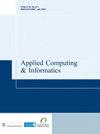Neural networks for anatomical therapeutic chemical (ATC) classification
IF 4.9
Q1 COMPUTER SCIENCE, INFORMATION SYSTEMS
引用次数: 2
Abstract
PurposeAutomatic anatomical therapeutic chemical (ATC) classification is progressing at a rapid pace because of its potential in drug development. Predicting an unknown compound's therapeutic and chemical characteristics in terms of how it affects multiple organs and physiological systems makes automatic ATC classification a vital yet challenging multilabel problem. The aim of this paper is to experimentally derive an ensemble of different feature descriptors and classifiers for ATC classification that outperforms the state-of-the-art.Design/methodology/approachThe proposed method is an ensemble generated by the fusion of neural networks (i.e. a tabular model and long short-term memory networks (LSTM)) and multilabel classifiers based on multiple linear regression (hMuLab). All classifiers are trained on three sets of descriptors. Features extracted from the trained LSTMs are also fed into hMuLab. Evaluations of ensembles are compared on a benchmark data set of 3883 ATC-coded pharmaceuticals taken from KEGG, a publicly available drug databank.FindingsExperiments demonstrate the power of the authors’ best ensemble, EnsATC, which is shown to outperform the best methods reported in the literature, including the state-of-the-art developed by the fast.ai research group. The MATLAB source code of the authors’ system is freely available to the public at https://github.com/LorisNanni/Neural-networks-for-anatomical-therapeutic-chemical-ATC-classification.Originality/valueThis study demonstrates the power of extracting LSTM features and combining them with ATC descriptors in ensembles for ATC classification.神经网络在解剖治疗化学分类中的应用
目的解剖治疗化学(ATC)自动分类技术因其在药物开发中的潜力而发展迅速。预测未知化合物的治疗和化学特性,以及它如何影响多个器官和生理系统,使得自动ATC分类成为一个重要但具有挑战性的多标签问题。本文的目的是通过实验推导出不同特征描述符和分类器的集成,用于ATC分类,其性能优于最先进的技术。设计/方法/方法所提出的方法是由神经网络(即表格模型和长短期记忆网络(LSTM))和基于多元线性回归的多标签分类器(hMuLab)融合产生的集成。所有分类器都在三组描述符上进行训练。从训练好的lstm中提取的特征也被输入到hMuLab中。对集合的评估在一个基准数据集上进行比较,该基准数据集来自KEGG(一个公开可用的药物数据库)的3883种atc编码药物。实验证明了作者最好的集合,EnsATC的力量,它被证明优于文献中报道的最好的方法,包括由fast开发的最先进的方法。人工智能研究小组。作者系统的MATLAB源代码可在https://github.com/LorisNanni/Neural-networks-for-anatomical-therapeutic-chemical-ATC-classification.Originality/valueThis上免费获得。研究展示了提取LSTM特征并将其与ATC描述符组合在集成中用于ATC分类的功能。
本文章由计算机程序翻译,如有差异,请以英文原文为准。
求助全文
约1分钟内获得全文
求助全文
来源期刊

Applied Computing and Informatics
Computer Science-Information Systems
CiteScore
12.20
自引率
0.00%
发文量
0
审稿时长
39 weeks
期刊介绍:
Applied Computing and Informatics aims to be timely in disseminating leading-edge knowledge to researchers, practitioners and academics whose interest is in the latest developments in applied computing and information systems concepts, strategies, practices, tools and technologies. In particular, the journal encourages research studies that have significant contributions to make to the continuous development and improvement of IT practices in the Kingdom of Saudi Arabia and other countries. By doing so, the journal attempts to bridge the gap between the academic and industrial community, and therefore, welcomes theoretically grounded, methodologically sound research studies that address various IT-related problems and innovations of an applied nature. The journal will serve as a forum for practitioners, researchers, managers and IT policy makers to share their knowledge and experience in the design, development, implementation, management and evaluation of various IT applications. Contributions may deal with, but are not limited to: • Internet and E-Commerce Architecture, Infrastructure, Models, Deployment Strategies and Methodologies. • E-Business and E-Government Adoption. • Mobile Commerce and their Applications. • Applied Telecommunication Networks. • Software Engineering Approaches, Methodologies, Techniques, and Tools. • Applied Data Mining and Warehousing. • Information Strategic Planning and Recourse Management. • Applied Wireless Computing. • Enterprise Resource Planning Systems. • IT Education. • Societal, Cultural, and Ethical Issues of IT. • Policy, Legal and Global Issues of IT. • Enterprise Database Technology.
 求助内容:
求助内容: 应助结果提醒方式:
应助结果提醒方式:


